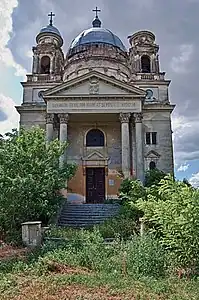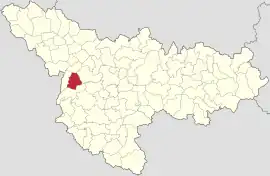Cenei | |
|---|---|
 The ruins of the church in Bobda, former mausoleum of the Csávossy counts and Roman Catholic church | |
 Coat of arms | |
 Location in Timiș County | |
 Cenei Location in Romania | |
| Coordinates: 45°43′N 20°54′E / 45.717°N 20.900°E | |
| Country | Romania |
| County | Timiș |
| Government | |
| • Mayor (2020–2024) | Sârgean Tanasin[1] |
| Area | 60.13 km2 (23.22 sq mi) |
| Population (2021-12-01)[3] | 2,760 |
| • Density | 46/km2 (120/sq mi) |
| Time zone | EET/EEST (UTC+2/+3) |
| Postal code | 307100–307101 |
| Vehicle reg. | TM |
| Website | primariacenei |
Cenei (Hungarian: Csene; German: Tschene; Serbian: Ченеј, romanized: Čenej; Croatian: Čenej) is a commune in Timiș County, Romania. It is composed of two villages, Bobda and Cenei (commune seat). It also included Checea until 2004, when it was split off to form a separate commune.
History
Cenei is one of the oldest settlements in Banat, first recorded in 1221 as a property of the archdiocese of Ittebe, today in Serbian Banat. By 1330 it belonged to the Sărad Fortress. Cenei was the site of a battle between the Turkish and Austrian troops on 20 August 1696.[4]
As of 1720, the natives were mostly Romanians and Serbs. Through the efforts of the Vuketići family, Cenei was colonized with Croats between 1801 and 1820.[5] German settlers arrived here only after 1848,[5] much later than other nearby settlements. The Hungarian population did not settle here in waves of colonists, but gradually, over a long period of time. Today's village was formed by merging Ceneiu Sârbesc ("Serbian Cenei"; Serbian: Српски Ченеј, romanized: Srpski Čenej) and Ceneiu Croat ("Croatian Cenei"; Croatian: Hrvatski Čenej) in 1902.[5]
Demographics
Cenei had a population of 2,670 inhabitants at the 2011 census, down 7% from the 2002 census. Most inhabitants are Romanians (67.23%), larger minorities being represented by Serbs (16.1%), Hungarians (8.8%) and Germans (1.46%). For 5.36% of the population, ethnicity is unknown.[6] By religion, most inhabitants are Orthodox (62.17%), but there are also minorities of Serbian Orthodox (15.43%), Roman Catholics (11.09%) and Pentecostals (3.41%). For 5.36% of the population, religious affiliation is unknown.[7]
| Census[8] | Ethnic composition | |||||
|---|---|---|---|---|---|---|
| Year | Population | Romanians | Hungarians | Germans | Serbs | Croats |
| 1880 | 3,892 | 841 | 255 | 1,437 | 1,242 | – |
| 1890 | 4,193 | 833 | 213 | 1,714 | 1,187 | 149 |
| 1900 | 4,233 | 832 | 317 | 1,575 | 1,223 | 114 |
| 1910 | 3,917 | 830 | 304 | 1,205 | 1,446 | 96 |
| 1920 | 950[lower-alpha 1] | 669 | 74 | 200 | – | – |
| 1930 | 3,800 | 958 | 236 | 1,216 | 1,196 | – |
| 1941 | 3,609 | 1,087 | 193 | 1,051 | – | – |
| 1956 | 3,554 | – | – | – | – | – |
| 1966 | 3,546 | 1,421 | 374 | 573 | 1,156 | – |
| 1977 | 3,487 | 1,570 | 384 | 468 | 987 | 43 |
| 1992 | 3,091 | 1,915 | 334 | 110 | 683 | 18 |
| 2002 | 2,868 | 1,920 | 299 | 65 | 531 | 17 |
| 2011 | 2,670 | 1,795 | 235 | 39 | 430 | 4 |
Notes
- ↑ Data on Cenei's population missing
References
- ↑ "Results of the 2020 local elections". Central Electoral Bureau. Retrieved 16 June 2021.
- ↑ "Primăria Cenei". Ghidul Primăriilor.
- ↑ "Populaţia rezidentă după grupa de vârstă, pe județe și municipii, orașe, comune, la 1 decembrie 2021" (XLS). National Institute of Statistics.
- ↑ Murphey, Rhoads (1998). Ottoman Warfare, 1500-1700. Routledge. p. 214. ISBN 9781857283891.
- 1 2 3 "Fișa Primăriei comunei Cenei pe anul 2020". Consiliul Județean Timiș.
- 1 2 "Tab8. Populația stabilă după etnie – județe, municipii, orașe, comune". Institutul Național de Statistică. Archived from the original on 2016-01-18. Retrieved 2021-09-20.
- 1 2 "Tab13. Populația stabilă după religie – județe, municipii, orașe, comune". Institutul Național de Statistică. Archived from the original on 2020-08-07. Retrieved 2021-09-20.
- ↑ Varga, E. Árpád. "Temes megye településeinek etnikai (anyanyelvi/nemzetiségi) adatai 1880-2002" (PDF). Archived from the original (PDF) on 2007-06-10. Retrieved 2021-09-20.
